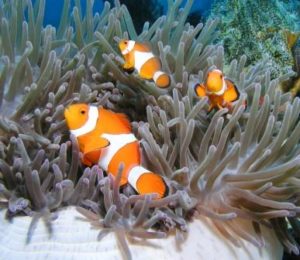
The take-home message from the hit Disney/Pixar movie Finding Nemo is clear – don’t take fish off the reef.
But a decade after the box-office hit was released, clownfish have continued to be a highly sought-after commodity, with the increased demand from pet shops causing a decline in wild populations.
In a bid to prevent over-collection, Flinders University is currently breeding clownfish and selling them to local aquarium shops at a cheaper rate than fish bought from the wild.
Dubbed Saving Nemo, the project enables students to learn how to breed and care for clownfish while also providing stock to aquariums stores, reducing the need to order wild caught fish.
Hundreds of clownfish have been bred across a number of different species since the initiative started in 2012, with the program now expanding into other tropical fish and shrimp species.
“Clownfish populations have decreased in some collection areas of the Great Barrier Reef since Finding Nemo was released, which is the exact opposite of what the film is portraying,” Saving Nemo project leader Ms Karen Burke da Silva said.
“The whole moral of the story is don’t take these little fish off the Reef and stick them in a tank but everyone wanted a Nemo after the film came out, and now in some areas of the Reef there are no clownfish left at all.”
Ms Burke da Silva, a biologist, said the public was largely unaware that most tropical fish sold in pet shops, including clownfish, were taken from the wild.
“Most people think the fish they buy in pet shops have been bred in captivity but the vast majority of tropical fish are actually taken from the wild.
“The other thing people don’t realise is that clown fish can live for up to 30 years in the wild so we’re grabbing fish that could possibly be quite old and sticking them in tanks not knowing how to properly care for them and as a result they’re dying.
“It seems like such a waste, it’s a tragedy.”
While the Great Barrier Reef Marine Park Association has set good bag limits on the number of clownfish that can be legally taken from the ocean, Ms Burke da Silva said there should also be consideration of the age and sex of fish which are removed.
She said that although clownfish were not classified as endangered, the entire Great Barrier Reef was under threat from pollution, climate change and over-collection.
“At the moment every living thing on the Reef is vulnerable. The fear is if we aren’t able to protect the reef now, it could be gone in the not too distant future.
“But if we stop taking clownfish and other animals in such high numbers and care for the Reef in a better way then we might be able to salvage this beautiful natural wonder.”
Through captive breeding and education programs, Ms Burke da Silva said she hoped more consumers would demand to buy captive bred marine fish for their tanks instead of removing them from the wild.
“Clownfish are relatively simple to breed when you know the process so we’re hoping to eventually be able to provide not just clownfish but a variety of other marine ornamental fish and invertebrates, perhaps even anemones which have proven to be much more difficult to raise in captivity.
“In this way we hope our program can expand within the Animal House facility at Flinders to eventually reduce the number of organisms taken from the Reef.”

